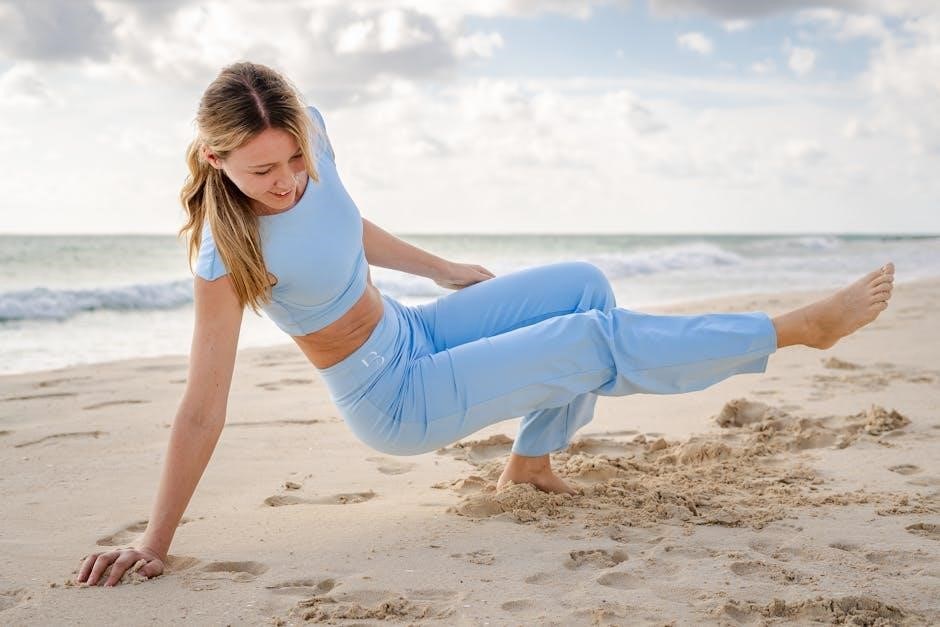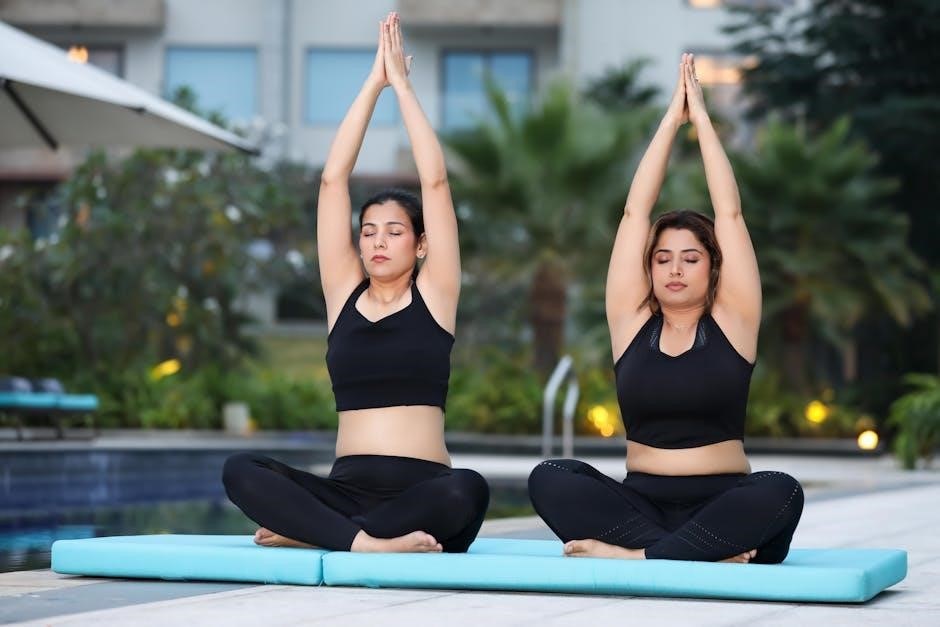Stretching exercises improve flexibility, prevent injuries, and enhance blood circulation․ Free downloadable PDF guides offer structured routines for full-body stretching, catering to all fitness levels and goals․
1․1 What Are Stretching Exercises?
Stretching exercises involve movements that lengthen muscles and improve flexibility․ They include static stretches (held for 15-30 seconds) and dynamic stretches (moving through ranges of motion)․ These exercises target specific muscle groups, enhancing elasticity and joint mobility․ Regular stretching improves posture, reduces muscle tension, and prevents injuries․ Free downloadable PDF guides provide structured routines, making it easy to incorporate stretching into daily life․ Whether for athletes or desk workers, stretching promotes relaxation and overall well-being․ Printable charts and plans ensure consistency, offering a comprehensive approach to maintaining flexibility and muscle health․ Stretching is a simple yet powerful tool for enhancing physical fitness and reducing stress․
1․2 Importance of Stretching in Daily Life
Stretching improves flexibility, reduces muscle stiffness, and enhances blood circulation․ It helps prevent injuries, alleviates back and joint pain, and promotes better posture․ Regular stretching can reduce stress, improve balance, and boost overall physical and mental well-being․ Incorporating stretching into daily routines, even during work breaks, can counteract prolonged sitting and enhance productivity․ It is beneficial for athletes, desk workers, and individuals of all fitness levels․ Stretching strengthens muscles, improves range of motion, and supports recovery after exercise․ By making stretching a daily habit, individuals can maintain mobility, reduce muscle tension, and enjoy a healthier, more active lifestyle․ It is a simple yet effective practice for long-term health benefits․

Types of Stretching Exercises
Stretching exercises include static, dynamic, and ballistic stretches․ Static stretches hold positions for 15-30 seconds, improving flexibility․ Dynamic stretches involve movement, ideal for warm-ups, while ballistic stretches use bouncing, though often discouraged․
2․1 Static Stretching
Static stretching involves holding a stretch for 15-30 seconds to lengthen muscles and improve flexibility․ It’s most effective after warming up or dynamic stretching․ This method targets specific muscle groups, promoting relaxation and reducing muscle tension․ Static stretches are gentle and ideal for beginners, as they minimize injury risk․ Many free downloadable PDF guides detail static stretching routines, providing clear instructions and visuals․ Regular practice enhances range of motion and alleviates stiffness, making it a cornerstone of fitness routines․ Static stretching is recommended for cooling down post-workout, ensuring muscles recover effectively․ It’s a simple yet powerful tool for overall muscle health and flexibility․
2․2 Dynamic Stretching
Dynamic stretching combines movement with stretching, engaging muscles actively․ It’s ideal for warming up before workouts, improving flexibility, and enhancing athletic performance․ Unlike static stretching, dynamic stretches involve controlled movements that mimic workout actions․ Free PDF guides often include dynamic routines, such as arm circles, leg swings, and torso twists․ These exercises prepare muscles for physical activity, boost blood flow, and reduce injury risk․ Dynamic stretching is particularly beneficial for athletes and individuals with active lifestyles, as it improves coordination and range of motion․ Regular practice enhances overall mobility, making it a crucial component of any exercise regimen․

Benefits of Regular Stretching
Regular stretching enhances flexibility, prevents injuries, improves blood circulation, and reduces stress․ It promotes relaxation, boosts posture, and increases energy levels, benefiting overall health and well-being․
3․1 Improved Flexibility
Regular stretching enhances flexibility by elongating muscles and tendons, allowing for a greater range of motion․ This makes daily activities easier and improves athletic performance․ Consistency is key, as flexibility improves over time with regular practice․ Free downloadable PDF guides provide structured routines to target major muscle groups, ensuring comprehensive flexibility․ Improved flexibility also reduces stiffness and enhances posture, making it beneficial for both sedentary individuals and active athletes․ Incorporating stretching into your routine can lead to long-term gains in mobility and overall physical comfort․
3․2 Injury Prevention
Regular stretching exercises play a crucial role in injury prevention by enhancing muscle elasticity and joint stability․ When muscles are flexible, they are less likely to tear or strain during physical activity․ Stretching improves blood flow, reducing muscle imbalances that can lead to injuries․ Incorporating pre- and post-workout stretches helps prepare muscles for exertion and aids in recovery․ Free PDF guides often include injury prevention routines, focusing on high-risk areas like hamstrings, calves, and lower back․ By maintaining consistent stretching habits, individuals can significantly reduce the risk of sports-related injuries and improve overall physical resilience․
3․3 Enhanced Blood Circulation
Stretching exercises significantly improve blood circulation by promoting the efficient flow of oxygen and nutrients to muscles and tissues․ When muscles are stretched, blood vessels dilate, enhancing delivery of essential resources․ Improved circulation supports muscle function, accelerates recovery, and reduces soreness․ Regular stretching routines, often detailed in free PDF guides, target major muscle groups to maximize blood flow․ Enhanced circulation also aids in removing metabolic waste, fostering a healthier muscular system; Incorporating stretching into daily routines can prevent stiffness and promote overall well-being, ensuring optimal physical performance and long-term health benefits․
3․4 Stress Relief and Relaxation
Stretching exercises are a natural way to alleviate stress and promote relaxation․ By targeting tight muscles and improving flexibility, stretching helps reduce physical tension and mental fatigue․ Many free downloadable PDF guides include routines specifically designed to calm the mind and body․ Gentle stretches, such as those for the neck, shoulders, and lower back, can relieve stress-related muscle tightness․ Incorporating stretching into your daily routine can act as a form of meditation, helping you unwind and improve your overall mood․ Regular stretching fosters a sense of well-being, making it an excellent practice for managing stress and enhancing mental health․

Full Body Stretching Routine
A full body stretching routine includes exercises targeting major muscle groups, improving flexibility and posture․ Daily practice enhances overall mobility and reduces muscle tension․ Free PDF guides offer structured plans for all fitness levels․
4․1 Daily Stretching Exercises for Beginners
Daily stretching exercises for beginners are simple and effective, focusing on improving flexibility and posture․ Start with gentle stretches like neck rolls, shoulder shrugs, and cat-cow stretches․ Incorporate hamstring, hip flexor, and calf stretches to target major muscle groups․ Hold each stretch for 20-30 seconds to maximize benefits․ Perform these exercises after a warm-up or light activity to enhance effectiveness․ Consistency is key; aim to stretch daily to see gradual improvements in mobility and reduced muscle tension․ Printable guides and free PDF downloads provide step-by-step instructions, making it easy to follow a structured routine․ Patience and regular practice will lead to noticeable results over time․

Stretching Exercises for Specific Muscle Groups
Targeted stretches for neck, shoulders, back, hips, arms, and core improve flexibility and relieve tension․ Free downloadable PDF guides provide structured routines for each muscle group․
5․1 Neck and Shoulder Stretches
Neck and shoulder stretches are essential for relieving tension and improving posture․ Simple exercises like chin tucks and shoulder rolls can reduce muscle strain․ Free PDF guides offer detailed routines, including side-to-side neck stretches and upright chest stretches, to target these areas effectively․ These stretches are particularly beneficial for desk workers and individuals with sedentary lifestyles․ Regular practice can help alleviate stress-induced tightness and enhance overall mobility․ The downloadable PDFs provide clear instructions and visuals, making it easy to incorporate these stretches into your daily routine for long-term relief and improved flexibility in the neck and shoulder region․
5․2 Back and Lower Back Stretches
Back and lower back stretches are crucial for improving posture and reducing muscle tension․ Exercises like the cat-cow stretch and child’s pose target the upper and middle back, while the knee-to-chest stretch and pelvic tilt focus on the lower back․ These stretches are gentle and effective for relieving stiffness and enhancing flexibility․ Free downloadable PDF guides provide detailed instructions and visuals for performing these exercises correctly․ Regular practice can help alleviate back pain, especially for those with sedentary lifestyles or jobs involving heavy lifting․ Incorporating these stretches into your routine can promote better spinal alignment and overall comfort, making them a valuable addition to any stretching regimen․
5․3 Hip and Leg Stretches
Hip and leg stretches are essential for improving flexibility and reducing muscle tightness․ Exercises like the standing hamstring stretch and sitting hamstring stretch target the back of the legs, while the hip flexor stretch focuses on the front of the hips․ These stretches are particularly beneficial for runners and those with desk jobs․ Free downloadable PDF guides often include detailed routines for hip and leg stretches, complete with visuals and step-by-step instructions․ Regular practice can enhance mobility, prevent injuries, and alleviate discomfort from prolonged sitting or physical activity․ Incorporating these stretches into your daily routine can significantly improve your overall lower body flexibility and comfort․
5․4 Arm and Chest Stretches
Arm and chest stretches are vital for improving posture, reducing muscle tension, and enhancing mobility․ Exercises like the chest stretch and shoulder stretches target the pectoral muscles and deltoids, promoting better flexibility․ The “Abs Overhead Slide Stretch” and “Chest Stretch” are effective for opening up the chest and relieving tightness․ Free downloadable PDF guides often include detailed routines for arm and chest stretches, complete with step-by-step instructions․ Regular practice can improve range of motion, reduce discomfort from desk work, and enhance overall upper body flexibility․ These stretches are simple to perform and can be incorporated into daily routines for long-term benefits․
5;5 Core and Abdominal Stretches
Core and abdominal stretches improve posture, reduce lower back pain, and enhance overall stability․ Exercises like the “Cat-Cow Stretch” and “Knee to Chest Stretch” target the abdominals and lower back muscles, promoting relaxation and flexibility․ Free PDF guides provide comprehensive routines, often including movements that strengthen and stretch the core․ Regular stretching can improve balance, athletic performance, and reduce muscle tightness․ These exercises are simple, effective, and can be done at home, making them ideal for incorporating into daily routines․ Consistent practice supports long-term core health and overall well-being, ensuring better mobility and reduced risk of injury․

Morning Stretching Routine
Starting your day with simple stretches can boost energy and flexibility․ Find easy morning exercises in our free PDF guide for a refreshing routine․
6․1 Simple Morning Stretching Exercises
Begin with gentle neck rolls and shoulder shrugs to relieve tension․ Follow with chest opens, side stretches, and hip flexor releases․ These simple exercises from our free PDF guide help increase flexibility and set a positive tone for the day․ Each stretch can be done in just a few minutes, making it easy to incorporate into your morning routine․ Focus on deep breathing and holding each stretch for 20-30 seconds․ Avoid bouncing and listen to your body to ensure a safe and effective practice․ Start your day feeling refreshed and energized with these easy-to-follow morning stretches․
Safety Tips for Stretching
Always warm up before stretching and avoid bouncing․ Listen to your body, stop if pain occurs, and hold stretches for 20-30 seconds․ Free PDF guides emphasize these safety measures․
7․1 Avoiding Bouncing or Forced Stretching
Avoid bouncing or forcing stretches, as this can cause muscle tears or spasms․ Instead, hold stretches statically for 20-30 seconds to allow muscles to relax and lengthen safely․ Free PDF guides emphasize gentle, controlled movements to prevent injury and promote effective stretching․ Always warm up before stretching and listen to your body to avoid discomfort․ If pain occurs, stop immediately and consult a professional․ Proper technique ensures maximum benefits while minimizing risks․ Printable charts often highlight this tip to encourage safe practices․ Remember, stretching should enhance flexibility, not cause harm․ Follow the guidance in free downloadable resources for injury-free results․
7․2 Listening to Your Body
Listening to your body is crucial during stretching exercises․ Honor your limits and avoid pushing past pain or discomfort․ Free PDF guides often stress the importance of gentle, controlled movements․ If a stretch feels painful, modify or stop it immediately․ Pay attention to signs of fatigue or tension, as overstretching can lead to injury․ Adjust routines based on daily flexibility and energy levels; Printable charts and plans encourage self-awareness to ensure a safe and effective practice․ Remember, stretching should enhance well-being, not cause harm․ By tuning into your body’s signals, you can maximize benefits while maintaining safety․ This mindful approach fosters long-term flexibility and health․

Download free PDF guides offering comprehensive stretching routines, including full-body exercises and targeted muscle group stretches․ These resources provide clear instructions and printable charts for easy practice․
8․1 Features of a Good Stretching Guide PDF
A good stretching guide PDF should include detailed illustrations, clear instructions, and routines for different fitness levels․ It should cover various muscle groups and provide tips for proper technique․ The guide should be organized, with sections for dynamic and static stretches, and include safety precautions․ Many guides also offer customizable plans and progress tracking․ Features like printable charts and easy navigation enhance usability․ Ensure the guide is updated with the latest stretching methods and backed by professional recommendations for optimal results and injury prevention․
8․2 How to Download and Use the Stretching PDF
Downloading a stretching guide PDF is straightforward․ Visit a reputable website, locate the download link, and save the file to your device․ Open the PDF using a viewer like Adobe Acrobat․ Print the guide for easy reference or follow along digitally․ The PDF typically includes step-by-step instructions, images, and routines tailored for different goals․ Use the guide to create a daily or weekly stretching plan, focusing on specific muscle groups․ Track your progress and adjust routines as needed․ Ensure to warm up before starting and listen to your body to avoid overstretching․ Regular use of the guide can enhance flexibility and overall well-being․
8․3 Printable Stretching Charts and Plans
Printable stretching charts and plans are ideal for organizing your routine․ These charts often include visual guides, step-by-step instructions, and timelines for different exercises․ They target specific muscle groups like hamstrings, quads, and hip flexors․ Users can print charts to track progress or follow structured plans․ Many PDFs offer customizable schedules, allowing you to tailor routines to fitness goals․ Charts are visually appealing, making it easy to understand each stretch․ Printing them ensures you have a handy reference during workouts․ They are perfect for beginners and advanced individuals alike, providing clear guidance for effective stretching sessions․
Advanced Stretching Techniques
Advanced techniques like dynamic and active static stretching enhance flexibility and strength․ These methods, detailed in free PDF guides, are ideal for experienced individuals seeking deeper muscle engagement․
9․1 Active Static Stretching
Active static stretching combines dynamic movement with held stretches, enhancing flexibility and strength․ It involves contracting and lengthening muscles actively, improving range of motion․ This technique, detailed in free PDF guides, is ideal for experienced individuals․ It promotes deeper engagement and relaxation of targeted muscles․ Regular practice can enhance athletic performance and reduce injury risk․ Free downloadable resources provide structured routines and visual guides for proper execution․ This method is particularly effective for those seeking advanced stretching benefits beyond basic static stretches․

Stretching Exercises for Specific Activities
Stretching exercises can be tailored to specific activities like running or desk work, targeting the muscles used in each․ Free PDF guides offer specialized routines to improve performance and reduce injury risk․
10․1 Stretching for Runners
Runners benefit from specific stretches targeting the legs, hips, and lower back to improve flexibility and reduce injury risk․ Free PDF guides provide detailed routines, including pre- and post-run stretches, to enhance performance and recovery․ These exercises focus on hamstrings, quads, calves, and hip flexors, which are essential for runners․ Proper stretching can prevent common injuries like shin splints and IT band syndrome․ Many PDF resources offer step-by-step instructions with images, making it easy to incorporate these stretches into a daily routine․ Regular stretching helps runners maintain optimal form and endurance, ensuring they stay healthy and perform at their best․ Consistency is key to seeing results and preventing muscle tightness․
10․2 Stretching for Desk Workers
Desk workers can reduce muscle tension and improve posture with targeted stretches for the neck, shoulders, and back․ Free PDF guides offer simple, office-friendly exercises to relieve stiffness from prolonged sitting․ These routines often include shoulder rolls, neck stretches, and wrist extensions, which can be done at a desk․ Regular stretching helps prevent repetitive strain injuries and enhances overall comfort․ Many guides provide quick, 10-minute routines that can be incorporated into work breaks․ Stretching at work not only boosts physical health but also mental focus and productivity, making it an essential practice for anyone with a sedentary job․ Consistency is key to maintaining flexibility and avoiding long-term discomfort․

The Science Behind Stretching
Stretching improves flexibility by elongating muscle tissue and enhancing nervous system responses․ Regular stretching increases range of motion and reduces muscle stiffness, promoting overall mobility and comfort․
11․1 How Stretching Affects Muscle Tissue
Stretching improves flexibility by elongating muscle fibers and tendons, reducing muscle stiffness․ Regular stretching enhances neuromuscular coordination, allowing muscles to function more efficiently․ Over time, consistent stretching can lead to structural changes in muscle tissue, such as increased sarcomere length, which improves range of motion․ This process also reduces muscle soreness and enhances recovery after physical activity․ Additionally, stretching promotes blood flow, delivering oxygen and nutrients to muscle cells, which supports overall muscle health and function․ These physiological changes contribute to better mobility, reduced injury risk, and improved athletic performance, making stretching a vital component of any fitness or rehabilitation routine․
Regular stretching is essential for overall well-being, improving flexibility, and preventing injuries․ It enhances blood circulation, reduces muscle tension, and promotes relaxation․ With various routines available, including free downloadable PDF guides, incorporating stretching into daily life is accessible for everyone․ Whether for athletes, desk workers, or general health, consistent stretching offers numerous benefits․ By following proper techniques and listening to your body, you can achieve optimal results․ Embrace stretching as a lifelong practice to maintain mobility, reduce stress, and enhance physical performance․ Start your journey with a structured plan and enjoy the long-term advantages of a flexible, healthy body․

Additional Resources
Explore free downloadable PDF guides for stretching exercises, offering detailed routines and printable charts․ These resources provide structured plans to enhance flexibility and relaxation effectively․
13․1 Recommended Stretching eBooks
Discover comprehensive eBooks offering detailed stretching routines and exercises․ These guides provide step-by-step instructions, focusing on flexibility, relaxation, and muscle group targeting․ Many eBooks include printable charts, making it easy to follow along at home․ Features like quick-reference guides and customizable plans cater to various fitness levels․ Some eBooks specialize in specific areas, such as full-body stretching or desk exercises for office workers․ With free downloads available, these resources are accessible to everyone․ They often include tips for proper form and safety, ensuring a safe and effective stretching practice․ Whether you’re a beginner or advanced, these eBooks are invaluable for enhancing your stretching regimen․